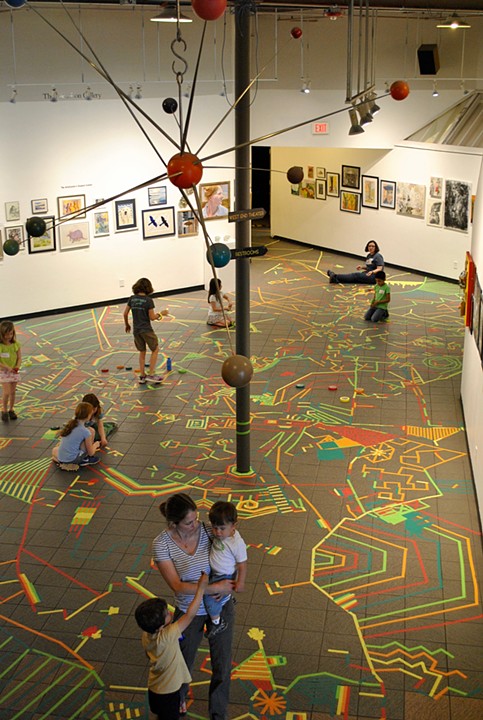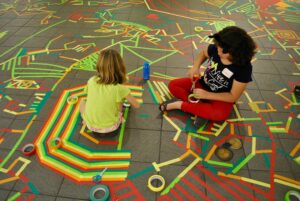Posted by Jenks Miller
Mary Carter Taub’s room-sized, neon duct tape installations look like a subway map, sharp lines crossing and recrossing each other at odd angles, resolute in their confusion, seeking every destination at once. Taub’s work has appeared on buses, in museums and restaurants, in markets and malls; the effect of her installations in consumer spaces is electrifying and disorienting: bold colors demand our attention, arousing both our animal instincts and our rational faculties as analytical thinkers. Overwhelmed, we want to venture further into this strange new space.
Taub is currently teaching an AfterSchool Arts Immersion Residency, working with students to create a mural on the floor of the Nicholson Gallery. The residency is funded by parents, friends of The ArtsCenter, the Nicholson Foundation and Orange County. The finished mural will be featured in the opening night of the ArtsCenter’s student exhibit on Friday, March 11th. I spoke with Mary Carter Taub as she began her residency at the ArtsCenter in Carrboro.

Many Chapel Hill and Carrboro residents will recognize your work from the “mobile mural” on the sides of a Chapel Hill transit bus (what we here at The ArtsCenter have been calling the “art bus”). Much of your other work is displayed in schools and in common areas where people work and play. Could you address the appeal of public spaces and discuss the ways in which your work transforms them?
I enjoy making art oriented in public space, outside of the traditional art museum and gallery network, allowing access to a broader audience. Public art is appealing because it highlights the overlap of art and everyday life, showing that both can even be one and the same. In my mind, public art is efficient, merging form and function. I like the challenge of connecting people in everyday life with a familiar space that has been altered (and hopefully energized) by my work to change the way the space is ordinarily viewed. It recontextualizes the space and is inclusive and accessible.
Not sure if this is relevant but…
Behavioral scientist Daniel Goleman describes creative organizations as a balance between explorer bees and worker bees: creative types and “law and order” types who keep things running smoothly. This metaphor resonates with me and explains why I am drawn to public art. It allows me to flex both my right brain and left brain muscles while satisfying my Type A and Type B tendencies under one hat that blends creativity and business/ government/ industry.
Is there a specific message you hope to convey in your public art installations?
In a macro sense I am interested in materialism and consumerism in our culture and my work is filtered through that lens from the use of color in my work (an off-the-shelf palette) and the choice of materials (usually, industrial goods) and imagery (typically mass produced). In a micro sense I am interested in my work connecting to the site in a way that resonates with the community. Before I begin a project I research to understand the site (and the community) within the context of its physical and cultural surroundings. I strive to add aesthetic distinctiveness and relevance to the site and the community with my artwork, otherwise, what’s the point?
Your work inserts itself directly into the dialog established by pop art, simultaneously critiquing and exploiting our voracious appetites as material consumers. If anything, our culture has become even more materialistic than it was in the days of Warhol and Lichtenstein. Is there a common thread running from the work of those artists in the ‘60’s to your work today?
Yes, definitely. I pluck materials and images from current consumer and popular cultures and dislocate them to recontextualize meaning. I think my work carries much less irony than that of many of the 60s artists and I am also not interested in kitsch which was prevalent in much of the 60s work. I am interested in mass-produced industrial products as materials (such as duct tape or electrical cables) because they have anonymity and less fixed meaning and less cultural significance than most consumer products that rely heavily on branding (such as a Barbie doll or Levi’s jeans).
I more directly identify with the 80s (vs the 60s) pop artists: Keith Haring, Basquiat, Sandy Skoglund and Stephen Sprouse. When I was 22 my mentor in grad school in the early 90s was Tommy Lanigan-Schmidt and he encouraged me to embrace my love of everyday materials– that was a real a-ha moment.
Researching, scouting and shopping for materials is an important part of my process. I tend to approach materials from a model of abundance (versus a model of scarcity) and try to imagine how I would use the material if I had tons of it and plenty of time to use it. I source materials from Home Depot, U-Line Corp, Wal-Mart and salvage sites to name a few.
In your artist statement, you say, “At a very visceral level, I am both mesmerized and horrified by these pop sensibilities and consumer behaviors.” I certainly experience the immediate, emotional response your work evokes. Do you feel that there is an additional political angle to your work, or are you concerned with the personal, emotional experience of material consumption?
I struggle with being seduced by material goods and being disgusted by them so in that regard I see my work as observation and reflection on how I currently live. My work does not aim to deliver a didactic or moral message on consumerism.
That said, I am a product of the 1980s when consumer consumption was at an all time high in the United States. Prior to the 1950s people bought things because they needed them. Over the decades there has been a steady shift from buying something you need to buying something you want because you can. Today’s purchases have sky rocketed to an unprecedented state of consumption that is in hyper overdrive and seems to be holding steady. Even in challenging economic times, we continue to buy lots of stuff that we do not need. My work reflects this material existence and is both celebration and repulsion of modern day purchasing power.
Whereas pop art often depicts identifiable images borrowed from mass culture, your work uses the raw materials of our modern lifestyles to create gently surreal abstractions. As an example, one of your sketches (which, we should note, are not “sketches” in the usual sense of the word, but are more like smaller-scale concept pieces) depicts coiled extension cables wrapped in neon zip-ties and boasting the slight protrusion of a small colored light bulb. At first glance, the piece looks like it’s been clipped from a hardware catalog. But looking closer, I’m struck with the absurdity and even the otherworldly beauty of these gadgets, as well as with the humor in the way you’ve juxtaposed the objects and their colors. Could you comment on the kind of abstraction at work in your pieces?
The materials in my work are relatable and accessible yet they are a departure from reality so abstract in that sense. I like to think that my work lends new significance to run-of-the-mill goods and products while exploring mass consumption on a personal scale and playing with abstracted ideas related to ephemera and permanence and the abstracted power of goods/ purchases.
My work is primarily process-oriented and improvisational and I rely heavily on intuition to make it. Even my permanent public artworks are process based at their core. For example, Mobile Mural was fabricated from a collage drawing (about the size of a skateboard) that I created by affixing colorful duct tape to Xerox paper. Many times I misplaced a piece of duct tape on the paper but it is not possible to remove it without ripping the paper so then the artwork takes a new direction because of that one “mistake.” It is a lemons-to-lemonade approach and I just make it work. It seems like a fitting metaphor for how we live life, react, adapt and move on.


Your residency at The ArtsCenter will involve the students in our afterschool program. How do children tend to interact with your work?
Children usually have a very visceral response, one of happiness and excitement, to my work. I am always so touched by how open-minded they are in embracing the unknown. Most kids spend their days in school where there is a heavy emphasis on structure, fine motor skills and staying within the lines. I think they detect authenticity and playfulness in my work and they can stay right there on the surface or they can delve deeper if they are curious.
I enjoy collaborating with kids to make art like the floor mural at ArtsCenter call Floored! Many heads and hands building the artwork means the work takes a direction that would not happen if I was working solo. Working in an improvisational way requires mindfulness and active engagement for everything to flow and I am repeatedly impressed by the kids’ ability to be present and in the moment. I wish I could say the same for most adults.
marycartertaub.com
artscenterlive.org
